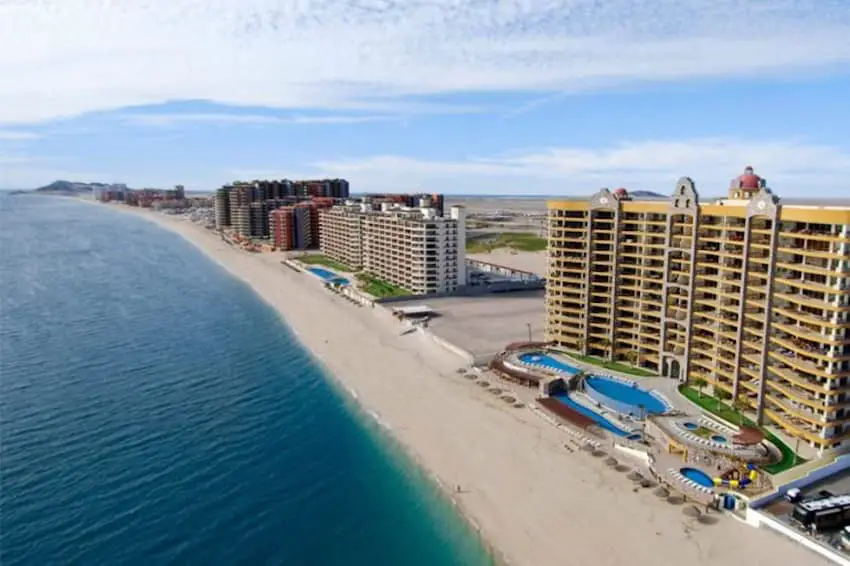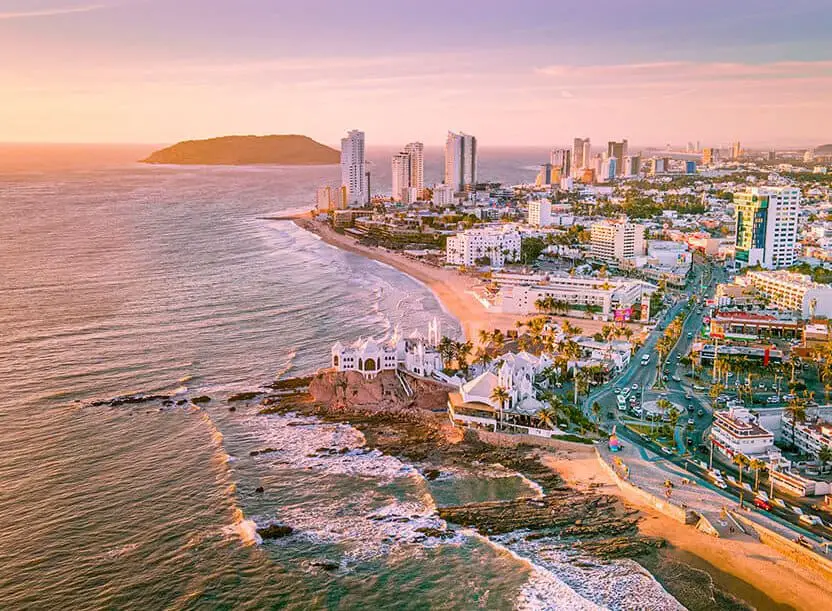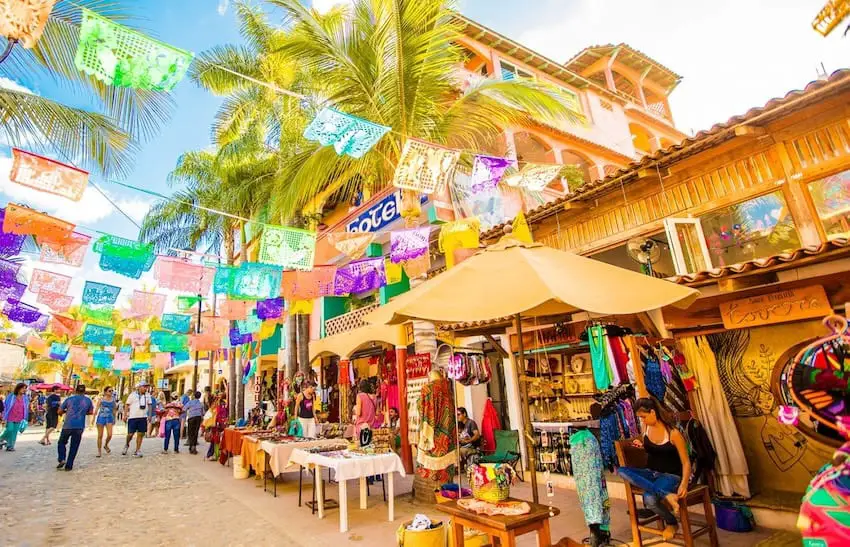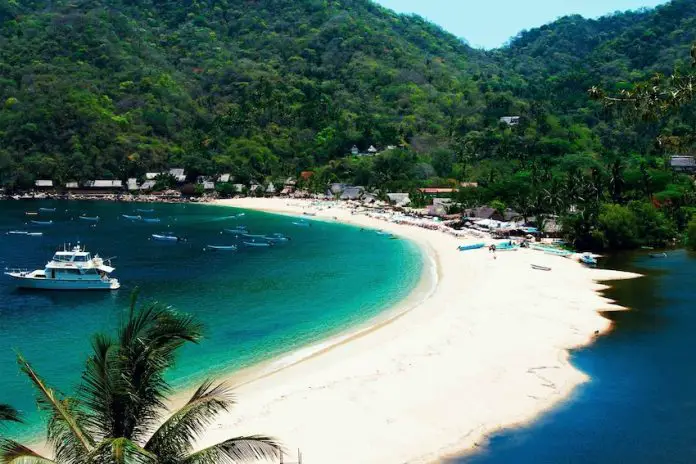With over 6,000 miles of coastline across four distinct oceans and seas, Mexico has more coastal variety than any country in Latin America. The blue Pacific, emerald Gulf of Mexico, azure Gulf of California and turquoise Caribbean afford scenic settings, climates and inland attractions to keep prospective retirees on an endless journey of discovery.
This week we focus on three diverse locations touching two of these great bodies of water — Arizona’s beach getaway of Puerto Peñasco, venerable and quintessentially Sinaloan Mazatlán and newcomer the Riviera Nayarit (admittedly more of a collection of smaller towns than a singular destination). From the desert north to the tropical south, these three west coast locations each call to distinct cohorts seeking a Mexico living future.
Puerto Peñasco

Puerto Peñasco (also known as Rocky Point) carries a colorful history of bootlegging by 1920’s gangsters. It slumbered along until the 1980’s when it was discovered by sea seeking Arizonans, who found a Gulf of California beach just 60 miles from the U.S.-Mexico border. Its population nearly doubled in the decade between 2000 and 2010 and today stands at 63,000. The tempo is driven by weekenders from Arizona and snowbirds hailing from Colorado, California, New Mexico and even some Canadians.
It’s mostly beachfront high rise condo living with some gated single-home communities dominated by foreign buyers. There’s a border-beach vibe and not much of Sonoran culture (head further south to Hermosillo, Kino Bay, Guaymas and Alamos for these ecosystems). There is, however, a scientific celebration of Sonoran marine and desert ecosystems, including museums and two UNESCO World Heritage Sites (the Island of the Gulf of California and the El Pinacate and Gran Desierto de Altar Biosphere Reserve).
It’s affordable (you can find rentals under US $500 per month), has distinct neighborhoods (Las Conchas, for example), a Jack Nicklaus golf course, and Mexican retail shopping box stores. There are also volunteer opportunities (American Legion, Adopt A Class, Rotary, pet rescues). Fall and Spring are idyllic with summers hot and winters seeing days in the 50 F (10 C) range.
Mazatlán

Mazatlán in neighboring Sinaloa (south of Sonora) certainly has earned its place as a pioneering Pacific seaport and resort. It began hosting U.S. visitors in the 1950s. The initial wave brought motorists and the camper crowd. International air started in the ’60s to ’70s and Mazatlán became a mainstay for west coast US visitors. Hotels like La Siesta, the Playa Mazatlán (owned for generations by a family from Newport Beach CA) and the legendary Carlos Anderson chain of bars/restaurants (Señor Frogs, El Shrimp Bucket) helped me (and millions more) define Mexico vacation bliss and spring-break debauchery.
Alas, other places (Los Cabos, Puerto Vallarta and the Mexican Caribbean) have surged ahead of Mazatlán. International flights have declined. As the bandwagon moved on, Mazatlán settled into a new reality of hosting more Mexican domestic visitors (thanks to a highway link from the highlands via neighboring Durango state) and winter charters from Canada and the U.S.
A setback? Not really. Foreigners choosing to move here are the big winners. Mazatlán (population 500,000) is still traditionally Sinaloan, profoundly friendly, affordable, artsy and scenic. Nearly everyone you meet here is a state native from Sinaloa (try to find that at other Mexican resorts; you won’t). Balancing a commercial fishing (shrimp) industry with tourism realities, the city offers one of Mexico’s most genuine welcomes. Prices for real estate and rentals trend cheaper than other mainstay resorts, and the economy is less dollarized due to the predominance of Mexican vacationers. Yes, Sinaloa is on the short list of narco hotbeds; however, incidents impacting Mazatlán (in general) and foreigners in particular are extremely rare.
There’s also a ton of ways to stay busy, both recreationally and culturally. There are quality golf courses, miles of flat and sandy Pacific beaches for water sports, Mexico’s longest malecón (boardwalk), three islands, a fine resort marina and a genuine Mexican colonial historic zone. Downtown boasts lovely 18th and 19th century structures, once abandoned and now mostly restored and beautifully illuminated at night.
City center plazas and the remarkable Teatro Ángela Peralta are centers for socialization and Mexico’s second-best beach city calendar of cultural events (that title goes to Acapulco, subject of an upcoming essay). The slate for ballet, symphony, opera, modern dance and popular music surrounds the city’s famed Carnaval celebration — one of the world’s best. If I ever decide to live on the coast, it’s Mazatlán for me.
Riviera Nayarit

Continuing south into the state of Nayarit, the vegetation gets greener and the Pacific bluer. Is the Rivera Nayarit really a place, or more an attitude? Nayarit is striving to craft an identity (Nuevo Nayarit) distinct from Puerto Vallarta, its dominating Jalisco neighbor. The Wixárika and Cora Indigenous peoples play historic, artistic and contemporary roles in coastal and inland settings. The entire state has but 1.2 million residents (ranking in 29th place). It’s taken decades to complete a modern toll highway between state capital Tepic, behemoth Guadalajara and the coast. That road is now almost complete, and the impacts on Nayarit will be profound.
Stretching north from Puerto Vallarta airport in neighboring Jalisco, a string of coastal communities was branded in the early 2000s using a “riviera” moniker. It reflects a sprawling assortment of settings both within Banderas Bay and further north along a wild and underdeveloped coast of fishing villages with a luxury resort persona. There are no real cities here (even bustling Bucerías, only has 16,000, not counting the Canadian and U.S. flood of winter residents). Other settlements are much smaller (Nuevo Nayarit, La Cruz, Punta Mita, Sayulita, San Pancho, Lo de Marcos and Rincón de Guayabitos don’t break 5,000 residents). So, if your thing is getting away from the resort crowds in a paradisical tropical setting, this is your place. You also have the PV box stores and medical services in Bucerías/PV, and the new bypass highway to get around the dozen traffic lights that impede your movement into neighboring Puerto Vallarta. Progress for sure.
You’ll have a choice to make when living here — either stay within the Bay of Banderas (conveniences, high rise condos, two marinas and gated communities) or venture north and find your village in the sun. Whichever you choose, your family and friends will love you for picking this scenic and serene place. There are more AAA Five Diamond resorts here (11) than almost any other state in Mexico (except Quintana Roo with 12). The golf course assortment is Pacific Mexico’s finest.
Might one of these three locations be the right fit? Take a hard look at your lifestyle intentions, drive from Arizona into Sonora, and continue south. You’re bound to discover if coastal living (desert or tropical) can be your new home solution.
The ratings
A full breakdown of our rating system can be found here.
![]()
What did we get right? What do you disagree with? Let us know in the comments.
You can see more of our Where to Live in Mexico 2024 series here, including ratings for Yucatán, Oaxaca, Quintana Roo, the Baja California peninsula and Jalisco.
Author Greg Custer lives in Mexico. He’s worked for over 40 years in international tourism, educating travel advisors around the world about Mexico and other Latin American destinations. He helps folks explore Mexico for living at www.mexicoforliving.com.
